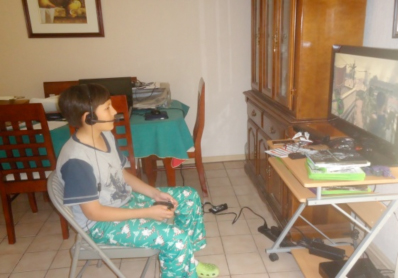EL PASO — At nine years of age and 100 pounds, Jorge can’t wait for the lunch bell to ring. He walks straight to the vending machine, like he does every day, to buy a large bag of chips and a soda. For Jorge, his school’s cafeteria food is not tasty enough and the lunch his mother packed for him is long gone. He is starving, despite having eaten breakfast and lunch a few hours ago.
Jorge’s eating behavior is similar to other children in El Paso and across the U.S., and is becoming more prevalent as childhood obesity rates continue to rise.
“Childhood obesity is not just a problem in Texas but it’s an issue that we’ve seen statewide, nationwide, and it’s a global epidemic,” says Xochiquetzalli Gamboa, consultant for the Pan American Health Organization, regional office of the World Health Organization U.S. – Mexico Border.

Childhood obesity is a statewide, nationwide, and global epidemic that has continued to rise across the U.S. (Diana Arrieta/Borderzine.com)
“We know that according to 2010 data released by the Robert Wood Johnson Foundation, one out of three children in the U.S. are reported overweight or obese, a rate that has tripled in young children over the past thirty years.”
Mirroring childhood obesity rates in the U.S., 17 percent of children in El Paso are overweight.
“Our obesity rates are really no different than any place else, so I would not say that El Paso is a fat city compared to the rest of the state or the country;” says Michael Kelly, senior program officer for the Paso del Norte Health Foundation.
It is a health problem that has germinated for decades, according to health experts. One of these factors is known as “screen time.”
“Children spend so much time sitting in the house doing nothing, watching T.V., playing videogames, getting online, and playing on the computer, that they no longer exercise,” says Bill Coon, executive director for the YMCA, part of the El Paso Healthy Eating Coalition.
Encouraging kids to log off the computer, turn off the television, and get outside is crucial to combat this problem.

Screen time is one of the major factors contributing to the rise in childhood obesity rates. (Diana Arrieta/Borderzine.com)
“Walking to the store, doing gardening, and getting involved in physical activities, without necessarily having to do push-ups and sit-ups, is something that children aren’t doing and that is affecting childhood obesity rates,” Gamboa says.
However, the lack of physical activity and lengthy screen time invested by today’s children does not reflect a lifestyle experienced by previous generations.
“During my time as a child, there was no television, no computer, as well as many other technology-advanced forms of entertainment that today’s generation of children has,” says 84-year-old published author Elena Navarro, who has written extensively about health topics.
“Obesity wasn’t a major problem and children used to lead healthier lifestyles playing outside.”
While screen time and a lack of physical activity are two contributing factors to the rise in childhood obesity rates, poor diet and nutritional habits perpetuated by the commercial food industry also contribute to the epidemic.
“We’re talking about a new generation of children that is growing up with Macaroni and Cheese and instant dinners,” says Rosario Zabanal, pediatrician for the Centro San Vicente Health Center in El Paso.

Poor diet and nutrition habits in the middle of a changing food industry are leading children to gain weight. (Diana Arrieta/Borderzine.com)
“What children are eating isn’t necessarily the best quality – very few fruits and vegetables and a lot of sugar drinks and junk food.”
Poor nutritional habits are often enhanced by the tendency for families to dine out at fast food restaurants rather than prepare home-cooked meals.
“There is a strong connection between weight gain among children and the consumption of meals away from home, which often include energy-dense food and drinks that are high in calories,” Zabanal says.
Health experts say associated with this tendency to dine out is a vehicle-driven population that wants convenience.
“The changing roles in society are specifically related to the fact that nowadays, almost 80 percent of children have working mothers who tend to look for the fastest access to food outside of the home because of the lack of time or other reasons,” Coon says.
In addition, low socioeconomic status in the midst of a severe economic crisis is another factor associated with rising childhood obesity rates.

Changing roles in society are leading parents to buy the fastest, most convenient, and cheapest food available for children. (Diana Arrieta/Borderzine.com)
Affordability has become a challenge for many families who, when they can’t afford food, tend to buy the fastest, most convenient, and cheapest food available, says Kelly, with the Paso del Norte Health Foundation.
“This, in the end, affects the children of these families because they eat unhealthy.”
Statistically, while nearly 18 percent of El Paso residents with a college education are obese, the frequency of obesity increases to 37.7 percent for those with less than a high school education and lower economic status, a study by the Paso del Norte Health Foundation reveals.
This rise in childhood obesity rates is particularly troubling to physicians because the extra pounds are starting children on the path to health problems once confined to adults.
“Some of these health problems include developing diabetes as a teenager, developing problems with blood pressure, cholesterol, skin discoloration, along with psychological problems such as depression and anxiety,” says Patricia Law, pediatric nurse practitioner for the Centro San Vicente Health Center in El Paso.
Fear of these adverse health consequences on children is leading some local organizations to seek solutions.
“There are many programs that are going into place to help overweight children cope with this issue,” Gamboa says.
These alternatives include the Paso del Norte CATCH program, the Healthy Eating Active Living Planning Grant, and the Healthy Kids Healthy Communities Project.
“All of these programs ultimately seek to assist the local community in its effort to develop lifetime health habits for better nutrition and increased physical activity among children that will help reduce obesity,” Gamboa says.
